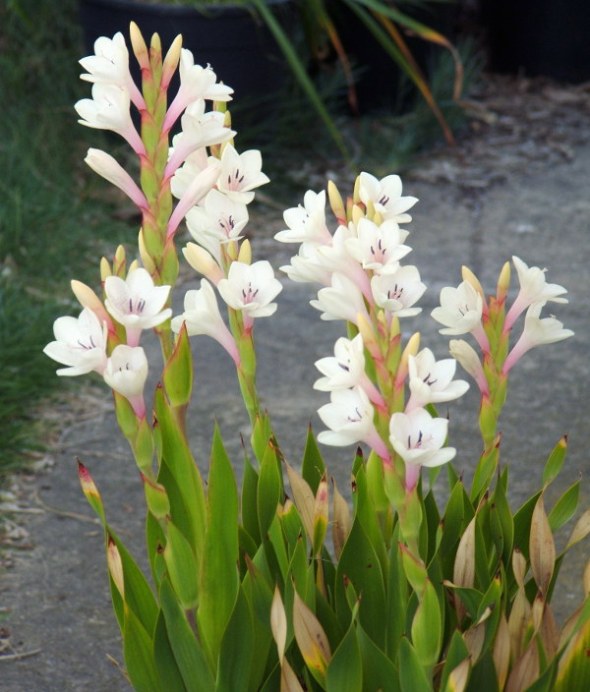Inflorescence cormlets in Watsonia meriana
Posted: February 6, 2024 Filed under: Botany | Tags: Iridaceae, Watsonia Leave a commentAll corms and cormlets produced by a Watsonia are axillary. Sympodial branching is a diagnostic character of the genus, with the main corm being exhausted by producing an annual flowering stem and one or several new lateral underground corms each subtended by a basal leaf. Additional smaller corms, variously called cormlets, cormils or bulbils are typically produced in the axils of lower cauline leaves in many species including W. aletroides (Burm.f.)Ker Gawl., W. humilis Miller and W. meriana (L.)Miller.
The Watsonia inflorescence is a spike with each solitary, sessile flower subtended by an outer bract and a less robust inner bract. The weedy variety W. meriana var. bulbillifera (J.Mathews & L.Bolus)D.A.Cooke is distinguished by having the lower flowers in its inflorescence replaced by clusters of cormlets. This variety is usually a sterile triploid depending on above-ground cormlets for dispersal, and is known as bulbil watsonia.
However, some genotypes of diploid W. meriana var. meriana can produce small solitary cormlets or cormlet clusters in the inflorescence, at least in cultivation. The extent of cormlet development is variable from one year to another; they are sometimes absent and are never as large or numerous as in var. bulbillifera.

Accession 183. At the right of the picture is a typical solitary cormlet 3mm wide produced in the axil of the reduced leaf subtending an inflorescence branch – but on the outside of that branch. This has been observed on all branches in six out of eight years. To the left is a cluster of six cormlets replacing the lowermost flower on the main axis; this has only been observed once.
-oOo-

Accession 187. A cluster of three cormlets replacing the lowermost flower of the inflorescence. This has only been observed once in eight years.
-oOo-
I used to wonder if the cormlet clusters of var. bulbillifera might be homologous to the twelve organs (six tepals, three stamens, three carpels) in a flower. This hypothesis was attractive because, although the number of cormlets in each closely packed cluster is variable, twelve is a typical number. The observations reported here make the hypothesis much less likely. There is a gradient transition from stem cormlets through inflorescence cormlets to clusters. The position of the cormlets in accession 183, axillary to the phyllome subtending an inflorescence branch but abaxial to that branch as if an extra axillary growing point, is rather surprising.
The consistent development of inflorescence cormlet clusters is still the morphological character separating var. bulbillifera from var. meriana. However, the difference should be understood as one of degree rather than a clear dichotomy.
Accession 183 was a gift from Mr Graeme Dallimore who collected it on Mornington Peninsula, Victoria. Accession 187 is said to be Cronin material discarded from Melbourne Botanic Garden in 1995. Both readily produce seed, implying that they are diploids.
-oOo-
References
Conran, J.G., Wilson, P.A. & Houben, A. (2004). Pollination and ploidy changes in South Australian populations of bulbil watsonia, Watsonia meriana (L.)Miller var. bulbillifera (J.Mathews & L.Bolus)D.A.Cooke (Iridaceae). Herbertia 57: 57-70.
Cooke, D.A. (1998) Bulbil watsonia is a variety of Watsonia meriana (L.)Miller (Iridaceae). J. Adelaide Bot. Gard. 18: 5-7.
Goldblatt, P. & Manning, J.C. (2020) Iridaceae of southern Africa. Strelitzia 42. (South African National Biodiversity Institute: Pretoria).
Watsonia fulgens
Posted: May 1, 2023 Filed under: Botany | Tags: Iridaceae, Watsonia Leave a commentWatsonia fulgens (Andrews)Pers. based on Antholyza fulgens Andrews was regarded as a nomen confusum by Goldblatt (1989) because the type illustration could not be matched to any wild population. Andrews’ description of this plant whch had been introduced to England in 1792 was little more than a diagnosis differentiating it from Antholyza ringens (= Babiana ringens): it had much longer glabrous leaves that remained green until new growth appeared, and bright scarlet, curved trumpet shaped flowers with large spreading lobes.
Ker Gawler (1802) treated it as a distinctive variety of Watsonia iridifolia (Jacq.)Ker Gawl., which is another name of uncertain application. An illustration by Planchon (1856) under W. iridifolia var. fulgens matches a clone that is still widely grown in Melbourne although apparently not commercially available. Planchon noted that it flowered in autumn with a scape to 1-2 metres long, far exceeding the leaves, simple or sometimes branched in vigorous specimens. Plants of this name were being sold in England by 1820 (Loddiges, 1820). In New South Wales, Macarthur (1843) had a plant he called Watsonia iridiflora fulgens and presented material to the Sydney Botanic Gardens in 1831.
The following description is based on accession 180 in my collection:
Evergreen, proliferating, to 150 cm tall. Basal leaves about 4, to 60 cm long, 35 mm wide, bright green with faint glaucous striations and thin green margins. Stem leaves 2, bract-like, slightly inflated. Flowers 24-28 (to 4 open at once) on a brown axis plus 0-2 short branches. Bract acute, to 19 mm long, exceeding the internode, brown-herbaceous. Bracteole subequal, obtuse or notched at apex. Perianth intense orange-red, with a paler star inside throat, alternating red and pale stripes inside tube. Tube to 49 mm long; basal part to 23 mm long; distal part cylindric, curved, to 26 mm long, 8 mm wide at mouth. Ridges absent. Lobes semi-flared with flat margins; outer acute, oblanceolate, to 27 mm long, 11 mm wide; inner elliptic, obtuse, to 28 mm long, 14 mm wide. Stamens closely arcuate with style, anthers 11 mm long, purple with purple pollen. Style branches far exceeding anthers, red with paler stigmas. Capsule cylindric, truncate, to 25 mm long, brown. Seeds with two short wings, 8-10 mm long, dark brown.
Unlike Watsonia tabularis and W. fourcadei, this plant is undamaged by full summer sun in Adelaide as long as it gets enough water. New shoots appear in January while the previous year’s leaves are still green. Flowering is irregular any time from April to September.


There is a superficial resemblance to photos of wild W. zeyheri in colouring: orange-red flowers on a dark axis. But accession 180 is clearly separated from this species by its size, truncate capsules, autumn-spring flowering season, non-thickened leaf margins and the rather characteristic pale star marking in the flowers.
One possible origin could be a garden selection from random hybrids between W. tabularis and W. zeyheri or W. angusta, with strong, hardy growth in cultivation due to F1 vigour. An irregular flowering season is common in Watsonia hybrids between parents with differing phenologies. It also resembles my hybrids of typical W. tabularis pollinated by W. fourcadei in such features as size, flower colour and capsule shape. The four species mentioned in this paragraph are closely related and were treated as the Subsection Angustae in Goldblatt’s revision.
Below is Planchon’s illustration. The prominent leaf venation may be the artist’s interpretation of the striated glaucous bloom emphasising the longitudinal veins.

And the type illustration from Andrews. Assuming it is the same plant as Planchon illustrated, this is less informative. Perhaps it was grown in shaded or otherwise unfavourable conditions, as he described it as only 3 feet tall.

The plant known as Watsonia fulgens has been a “thing” for over 200 years. If it does not match any wild population, perhaps it should be treated as a cultivar. Unfortunately the name has been loosely applied in horticultural literature, for example to W. angusta by Campbell (1986). Watsonia fulgens sensu Montague (1930) was probably a hybrid cultivar; it was described as having pale-rose flowers appearing early in spring. It was distributed by Law Somner (1933) and may have been identical to the Watsonia fulgens described as a deep pink in Brunning’s 1905 and 1918 catalogues.
-oOo-
References
Andrews, H.C. (1801) Botanist’s Repository 3: t.192.
Brunning, F.H. (1905) Manual of Seeds, Bulbs, Horticultural Sundries. (F.H. Brunning Pty Ltd: Melbourne).
Brunning, F.H. (1918) Winter Flowers, Bulbs, Spring Flowering Sweet Peas. (F.H. Brunning Pty Ltd: Melbourne).
Campbell, E. (1989) Watsonia. In Walters et al. (eds) The European Garden Flora 1: 385-386. (Cambridge University Press: Cambridge).
Goldblatt, P. (1989) The genus Watsonia. (National Botanic Gardens: Kirstenbosch).
Ker Gawler, J.B. (1802) The Botanical Magazine 17: t.600.
Law Somner Pty Ltd (1933) Law Somner Catalogue 1933-34. (Law Somner Pty Ltd: Melbourne).
Loddiges, C.L., Loddiges, G. & Loddiges W. (1820) Catalogue of Plants which are sold by Conrad Loddiges and Sons, nurserymen, at Hackney, near London. (Loddiges: London).
Macarthur, W. (1843) Catalogue of Plants Cultivated at Camden.
Montague, P. (1930) The new watsonias should be freely grown. The Australian Garden Lover 6: 33.
Persoon, C.H. (1805) Synopsis Plantarum 1: 42.
Planchon, J.E. (1856) Flore des Serres et des Jardins de l’Europe. 11: 1.
A partial checklist of named Watsonia cultivars
Posted: July 20, 2022 Filed under: Botany | Tags: Iridaceae, Watsonia Leave a commentWatsonia is a genus of the Iridaceae with about 53 species in southern Africa. They are perennial herbs growing from corms and producing spikes of showy flowers adapted to pollination by birds or insects. The species are generally interfertile, all being outbreeders with the same diploid chromosome number. Their wide range in size, phenology and flower colour, along with the ease of working with their large simple flowers, make them attractive subjects for collectors and amateur hybridists.
During the early 20th century there was interest in commercial production of named cultivars for home gardens and cut flowers, but the genus has been rather neglected since then. The following checklist is a ‘first pass’ through the referenced publications, with a bias toward those cultivars that have been released in Australia. It is not certain if every cultivar on this list is still extant.
You can download the list as a 210Kb pdf file from this link.

Watsonia ‘Leng’
DOI: 10.13140/RG.2.2.16217.39520
Watsonia coccinea
Posted: October 19, 2019 Filed under: Botany | Tags: botany, Iridaceae, Watsonia Leave a commentWatsonia coccinea Herbert ex Baker is native to the South-western Cape in seasonally wet sites on sandy flats.
It has been cultivated in Australia since the 1840s, sometimes under the misapplied name of W. humilis. The earliest recorded importation from the Cape was by Alexander Macleay of Elizabeth Bay via Captain Farquard Campbell in 1838. The specimen illustrated here was purchased from Tesselaars nursery in Victoria in 2002.
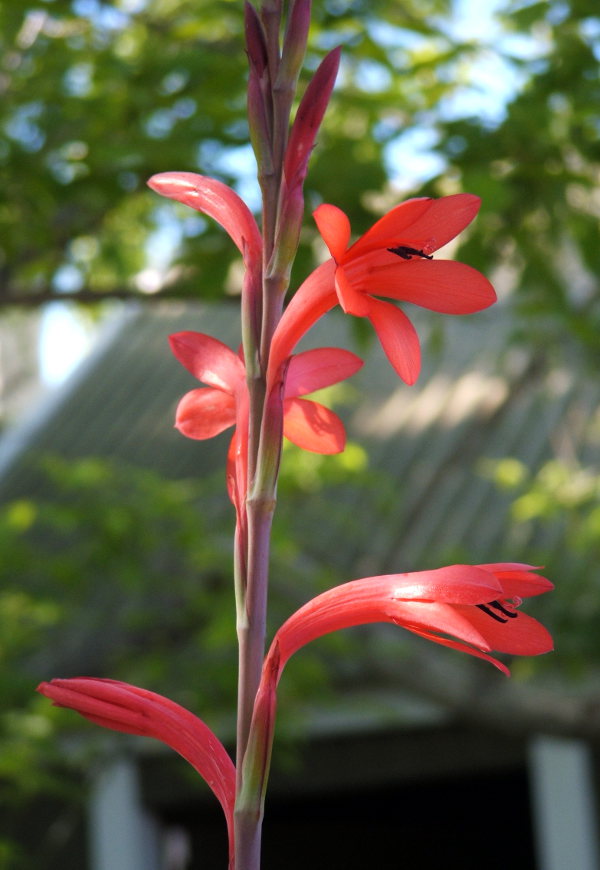
In cultivation it grows to 40 cm tall, exceptionally to 1 metre but never with more than 12 flowers. The bright scarlet perianth has an arched, narrow cylindrical tube 4-5 cm long marked internally with six darker red lines, and hooded lobes 24 to 28 mm long.
W. coccinea flowers later than many of the winter-growing watsonias, in late October and consequently the flowers are vulnerable to damage by thrips. It is less useful in the garden than the small forms of W. meriana for this reason, and because it is a “shy bloomer” with some full-sized corms producing only foliage if planted too densely or given less than full sunlight during the winter. It has apparently contributed its flower shape and warm colouration to a few of the cultivars bred by Cowlishaw and Cronin in the early 20th century, crossing with larger plants derived from W. borbonica.
References
Goldblatt, P. (1989) The genus Watsonia. 148 pp. (National Botanic Gardens: Kirstenbosch) ISBN 062012517
Macleay, A. (1843) Plants received at Elizabeth Bay. (Ms in Mitchell Library, Sydney, 2009/115).
Watsonia tabularis
Posted: October 6, 2017 Filed under: Botany | Tags: botany, Iridaceae, Watsonia 1 CommentWatsonia tabularis J.Mathews & L.Bolus has been in cultivation in Australia since the 19th century but does not appear to have contributed to the pedigrees of any hybrid cultivars bred in this country. It is endemic to the Cape Peninsula of South Africa and may be closest to the more widespread and variable Watsonia fourcadei J.Mathews & L.Bolus.
Plants grown from seed recently imported from South Africa have flowers of pale pink with a darker tube as shown in the photo. These represent the high altitude form; plants from lower altitudes differ in having bright orange flowers.
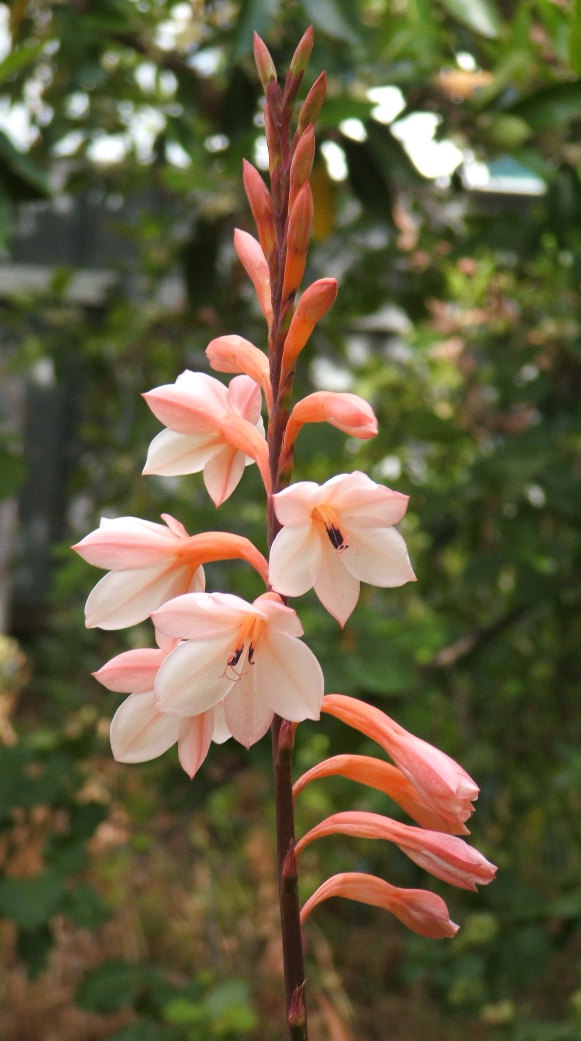
W. tabularis is evergreen, making most growth during autumn and spring then flowering in November to January.
Reference
Goldblatt, P. (1989) The genus Watsonia. 148 pp. (National Botanic Gardens: Kirstenbosch) ISBN 062012517
Watsonia pillansii
Posted: March 17, 2017 Filed under: Botany | Tags: Iridaceae, Watsonia Leave a commentWatsonia pillansii L.Bolus is widespread in the eastern (i.e. summer rainfall) part of South Africa at low and medium elevations. This wide geographic range is associated with variation in ecological requirements and plant size, but the flower colour is generally bright orange to orange-red.
Plants grown from seed recently imported from South Africa have unbranched stems to 1.2 m high bearing up to 22 flowers. They are evergreen, with new shoots appearing in late summer immediately after flowering and before the previous season’s leaves have died. Each flower has a cylindric tube 3.5 to 5 cm long and acute perianth lobes to 24 mm long that flare widely when fully open; the colour in this strain whose exact provenance is unknown is a rather weak orange-juice orange on the lobes and deeper on the outside of the tube. The anthers and pollen are cream.

Watsonia pillansii is related to W. schlechteri in the section Watsonia, subsection Grandibractea.
The species has been in cultivation in Australia since the 19th century. Cultivars that may be selections of W. pillansii include ‘Flame’ (marketed by Lawrence Ball in the 1940s) and ‘Watermelon Shades’ (Cheers, 1997). Watsonia ‘Beatrice’ or the Beatrice Hybrids is a group name for various natural hybrids of W. pillansii (Eliovson, 1968) that were exported to Britain, America and Australia in the early 20th century. The name comes from Watsonia beatricis J.Mathews & L.Bolus, which was a taxonomic synonym of W. pillansii.
References
Cheers, G. ed. (1997) Botanica. (Random House Australia).
Eliovson, S. (1968) Bulbs for the Gardener in the Southern Hemisphere. (Reed: Wellington).
Goldblatt, P. (1989) The Genus Watsonia. (National Botanic Gardens: Kirstenbosch) ISBN 062012517
Watsonia fourcadei
Posted: October 3, 2016 Filed under: Botany | Tags: Iridaceae, Watsonia 1 CommentWatsonia fourcadei J.Mathews & L.Bolus has been in cultivation in Australia since the 19th century but does not appear to have contributed to the pedigrees of any hybrid cultivars bred in this country. It is widespread in the mountains of the southern Cape but absent from the Cape Peninsula where it is replaced by the related W. tabularis J.Mathews & L.Bolus.
Plants grown from seed recently imported from South Africa have flowers in a range of pink shades from pale salmon with a darker tube to the medium pink shown in the photo. They are evergreen, making most growth in mid summer to autumn but flowering in October to December.
The flowers have an arched, narrow cylindric tube about 6 cm long and perianth lobes 26 to 32 mm long incurved to form a cup-shaped limb.
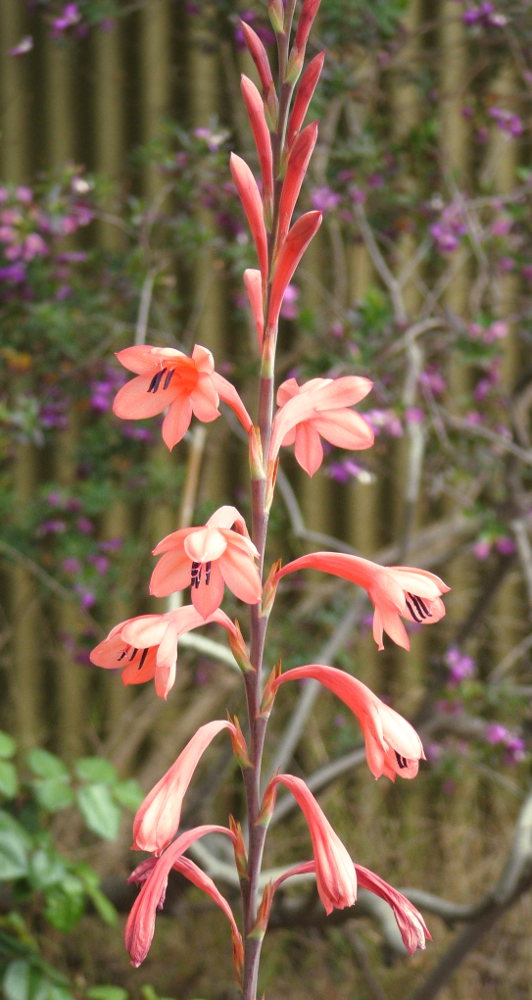
Reference
Goldblatt, P. (1989) The genus Watsonia. 148 pp. (National Botanic Gardens: Kirstenbosch) ISBN 062012517
Watsonia schlechteri
Posted: December 31, 2015 Filed under: Botany | Tags: botany, Iridaceae, Watsonia 1 CommentWatsonia schlechteri L.Bolus grows in the montane veld of the winter-rainfall parts of the Cape, South Africa. Plants grown from seed imported via Silverhill Seeds first flowered this year and are a good match for the lectotype of W. schlechteri.

The flowers are orange-vermillion with perianth lobes to 23 mm long. The buds end in a slightly downcurved point. There are no staminodal ridges in the perianth tube, a character that distinguishes it from the closely related W. pillansii. However, the fresh leaves of these specimens lack the strongly thickened margins and midvein that are used as another distinguishing character; these are only evident in dried material.
W. schlechteri is one of the smaller watsonias, usually much less than 1 metre tall with leaves about 40 cm long. It flowers in late December to January, resuming growth from offsets soon after flowering while the previous season’s shoot may still be green. Thus it has some leaves all year, or non-flowering plants may be briefly leafless before the new growth starts in late summer. Goldblatt notes that flowering in the wild is conditional on the plants not being shaded out by surrounding vegetation.
Like other watsonias native to high altitudes, it is at risk of damage in the agonisingly hot, dry summers we get here at sea level in Adelaide. The problem is to give the plants sufficient light without excess heat, a tall order on days of 42°C with northerly winds.
Reference
Goldblatt, P. (1989) The genus Watsonia. 148 pp. (National Botanic Gardens: Kirstenbosch).
Pedigrees of the Cronin watsonias
Posted: December 31, 2014 Filed under: Botany | Tags: botany, genetics, Iridaceae, Watsonia Leave a commentThe rediscovery of Mendel’s principles of heredity at the beginning of the 20th century inspired a surge of ornamental plant breeding by researchers, commercial nurserymen, and perhaps most importantly by individual gardeners.
John Cronin, Director of the Royal Botanic Gardens in Melbourne from 1909 to 1923, had a personal hobby of experimenting with the improvement of garden flowers. He aimed to demonstrate the application of Mendel’s laws to flower breeding, and encourage gardeners to make their own hybrids. He worked with Dahlia and other genera, but particularly the winter-growing South African watsonias, which he recognised as “everyone’s flower” – easy to grow, attractive, a natural for southern Australian gardens.
In a previous publication I lamented that the exact pedigrees of his Watsonia cultivars were lost with the destruction of his papers after his death in 1923. But now the National Library of Australia has come to the rescue with their wonderful resource of newspaper files at Trove. Cronin was a tireless populariser and communicator, speaking at the evening meetings of horticultural societies around the suburbs of Melbourne and giving interviews to journalists.
In the spring of 1904, while employed by William Guilfoyle at the Botanic Gardens, he crossed a pink Watsonia borbonica with W. borbonica ‘Arderne’s White’. This cross may be represented by the following formula (but note that the order is arbitrary, it is not known which was the pollen parent and which the ovule parent in any of the crosses discussed here):
borbonica × Arderne’s White
He noted that pink flowers were dominant over white in the F1 generation, as has been confirmed by other researchers. In spring 1907 he selected one F1 plant with tall stature, dense branching and large flowers. He crossed this with a purple Watsonia meriana and the widely grown red Watsonia aletroides, and also backcrossed it to W. borbonica ‘Arderne’s White’ to create three lines for further breeding:
1. meriana × (borbonica × Arderne’s White)
2. aletroides × (borbonica × Arderne’s White)
3. Arderne’s White × (borbonica × Arderne’s White)
Cronin’s appointment as Principal of Burnley Horticultural College in 1908 seems to have interrupted this work, and in the following year he succeeded Guilfoyle as Director of the Botanic Gardens. By 1913 he had time to resume his watsonia experiments, and on 20 March sowed seeds from his three 1907 crosses at the Botanic Gardens nursery. Six years is not an inordinately long time to store Watsonia seeds, but there would be some loss in viability which may have unintentionally favoured some genotypes over others. Cronin’s management of the plants was another possible source of selection pressure to produce watsonias adapted to Melbourne gardens: he left the corms in the ground over summer, and gave the plants no fertiliser or watering even though 1913-14 was a drought period.
This generation produced their first flowers in October 1914; Cronin stated that these resembled the 1907 selection in size and colour, and were inbred that year. I interpret this to mean that he produced an F2 generation in each of the three lines by cross-pollinating siblings, since selfing would have produced little or no seed due to incompatibility. Thus,
1. (meriana × (borbonica × Arderne’s White)) × (meriana × (borbonica × Arderne’s White))
2. (aletroides × (borbonica × Arderne’s White)) × (aletroides × (borbonica × Arderne’s White))
3. (Arderne’s White × (borbonica × Arderne’s White)) × (Arderne’s White × (borbonica × Arderne’s White))
Large numbers of these seedlings were raised in the main nursery of the Botanic Gardens. By October 1916 Cronin saw the first flowers of the inbreds, which had a wider range of colours than their parents. Some whites showed up, as would be expected from recombination, including some with flowers of improved size and form compared to the original ‘Arderne’s White’. The watsonias commercially released in the 1920s as the Commonwealth hybrids or “Watsonia Cronini” were selections from this generation.
Line 1 would have produced the many Cronin cultivars with a mixture of characters from W. meriana and W. borbonica. These often have subtle tertiary flower colours due to genes from both species influencing anthocyanin pigment production. Floral bracts are typically well-developed and obtuse, compared to the shorter acute bracts of W. borbonica. Examples include ‘Lilac Towers’, which is the most widely grown Watsonia in Australia today and may be the same as Cronin’s ‘Sydney’, and the one illustrated below which may be his ‘Maitland’.
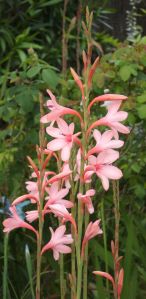
Line 2 would have yielded flowers with long tubes and small lobes like Watsonia aletroides. The one illustrated here was discussed in a previous post.
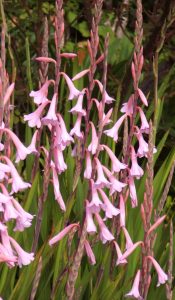
Cultivars from line 3 are not interspecific hybrids, but selections within the species Watsonia borbonica and would include Cronin’s improved whites such as this, which may be his ‘Hobart’.
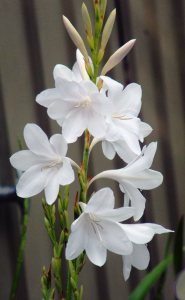
This is the same breeding program that was reported in less detail by Pescott (1926) and Cooke (1998).
It’s significant that Cronin did not use a long breeding program: the cultivars released were no more than three generations away from the original genotypes that had been imported from Africa in the 19th century. As he was working with a perennial that is normally propagated vegetatively, he could stop at the F2 with its fixed heterozygosity. I have bred watsonias four generations on from these and other old cultivars, and can attest that hybrid breakdown soon appears. Some of the resulting plants had interesting extremes of flower shape or colour, many were dwarf or weak in growth, but few were gardenable.
In the spring of 1917 Cronin presented this data to the horticultural correspondent of The Leader, and was lecturing on flower hybridisation to amateur horticultural societies with his new watsonias as exhibits. The following year he gave an interview to The Argus, repeating that his new watsonias were produced by first crossing and then inbreeding on Mendelian lines.
-oOo-
Sources
Anon. (1917) Melbourne Botanic Gardens – New colors in flowers – The laws of Mendel. The Leader (Melbourne), Saturday 10 November 1917 pp.13-14.
Anon. (1917) Horticultural society. The Advertiser (Footscray), Saturday 15 December 1917 p.3.
Anon. (1918) Botanic Gardens Experiments. The Argus (Melbourne), no.22,553. Monday 11 November 1918 p. 6.
Cooke, D.A. (1998) Descriptions of three cultivars in Watsonia (Iridaceae) J.Adelaide Bot. Gard. 18: 95-100.
Pescott, E.E. (1926) Bulb Growing in Australia. (Whitcombe & Tombs: Melbourne).
Watsonia humilis
Posted: May 4, 2014 Filed under: Botany | Tags: botany, Iridaceae, Watsonia Leave a commentWatsonia humilis Mill. is endemic to the Western Cape area of South Africa. It is winter growing and summer dormant like many other South African irids, restricted to a particular fynbos association on seasonally wet clay and loamy alluvial flats.
Its original range in the Breede River Valley between Tulbagh and Worcester, and the lowlands between Malmesbury, Franschhoek and Gordon’s Bay, has been reduced by 98%. Two populations are known to remain: one of fewer than 50 plants in an urban reserve at Gordon’s Bay and a second rediscovered in 2012 in the Breede River Valley near Wolseley, more than 80 km away. A third population may still exist between Somerset West and Sir Lowry’s Pass despite bulldozing by vandals in 2011.
Although critically rare in its natural habitat, it is secure in ex situ cultivation around the world. At least one strain has been passed between gardeners in Australia since its first importation in the 1830s.
Watsonia humilis is in the section Watsonia, subsection Watsonia of the genus. It is distinguished by its small size, unbranched inflorescence, strongly keeled bracts with outcurved tips and stamen filaments no longer than the perianth tube. Its pale coloured perianth (pale pink to white, never red) suggests that it is adapted to insect pollination unlike its larger and usually red-flowered relatives.
This watsonia can be grown in the open garden here but to keep track of the corms I grow it in 20 cm pots, lifting and dividing each summer. It multiplies vegetatively and I have used it as the ovule parent in hybridization.
The common form in Australian gardens has white perianth lobes and a tube shading to deep pink at the base. The F1 hybrids with bright red flowered W. meriana Mill. have uniformly pale pink flowers, the intensity and hue of the pink (anthocyanin) pigmentation varying slightly between individuals. This result shows that white flowers in this species have a different genetic basis to the recessive acyanic mutants of other species: it suggests incomplete dominance, possibly with more than one genetic locus involved. This is to be expected if white flowers were a stabilised local adaptation in the source population, rather than a passing mutation as in W. borbonica ‘Arderne’s White’. These hybrids lack the outcurved bract tips of W. humilis, which may be the most useful diagnostic character for recognising it.
References
Goldblatt, P. (1989) The genus Watsonia. (National Botanic Gardens: Kirstenbosch) ISBN 062012517
Goldblatt, P., Manning, J.C., Raimondo, D. & von Staden, L. (2013) Watsonia humilis Mill. National Assessment: Red List of South African Plants version 2013.1. Accessed on 2014/1/28.

